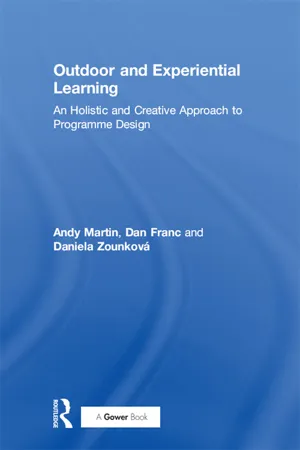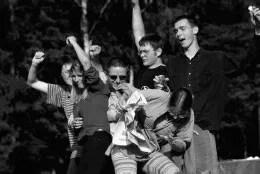![]()
PART 1
Theory: Methods and Application
Andy Martin
![]()
CHAPTER 1
The Evolution of an Holistic Process
The philosophy of experiential education is particularly necessary as a vehicle for change in the 21st century.
Itin, 1999, p.98.
Chapter overview
Adventure education has a number of characteristics, including a commitment to personal development, an adventure component, which need not necessarily be physical, some degree of uncertainty and risk taking, some challenge and reflection, a novel setting, a range of games, initiatives and activities, as well as the use of metaphors and debriefs. In order for these characteristics to be put into an experiential programme, special attention needs to be paid to programme design.
The first generation of outdoor adventure programmes emphasised personal growth through physical challenge and ‘letting the mountains speak for themselves’. Further generations have added an intellectual dimension by processing the experience through facilitation and review. However, increasingly approaches have been advocated that balance physical, intellectual, emotional, and spiritual aspects of personal development.
This chapter provides the background to outdoor education in the Czech Republic and an introduction to Vacation School Lipnice, whose courses have for 25 years provided opportunity for personal development, using an holistic approach involving a range of challenges other than physical.
Outdoor education in the Czech Republic
EDUCATIONAL ROOTS: COMENIUS
The work of the Czech educator John Amos Comenius (1592–1670), who was known throughout Europe as the Teacher of Nations, is particularly significant in the foundation and development of experiential and outdoor education. Comenius believed in educating the whole person, similar to today’s holistic education concepts. According to Comenius, it is necessary to educate the mind, the tongue, the heart and the hand. By this statement he meant that the most important experiences are the ones achieved by one’s own senses. He recognised the importance of travelling as a means of completing youth education and also supported the use of ‘games’ and ‘play’ in achieving educational outcomes. Comenius concluded that a learning process began and ended with experience and that teaching and learning must be interconnected with experience in nature and must prepare for life itself. In his main work The Great Didactic (Comenius, 1632/1907) he argued for the importance of:
• the interconnection of theory and experience
• the interrelationship between school subjects
• encouraging self-directed and self-motivated study and problem solving.
FOUNDATION: TURISTIKA ACTIVITIES
Czech history has been influenced by its position in the centre of Europe. Because of this geographical position the Czech people have been susceptible to various influences over the centuries. General interest in national history and nature in the mid-nineteenth century contributed to the creation of the physical education movement Sokol (1862) as well as the Turistický klub (1888). Turistika activities include active movement (travelling by bike, skis, canoe or on foot), and outdoor and cultural activities (learning about nature, local history and sights and the life of local people). By the end of the century there was a rapid development of outdoor sports. The English influenced the foundation of rowing clubs (1860) and the development of water sports. From the end of the nineteenth century cycling developed rapidly. At the same time the founders of the turisticka movement and most outdoor sports realised the broad connection between sports in nature and character building.
At the beginning of the twentieth century it was the Anglo-Saxon influence, linked to the scouting movement of Baden-Powell, which spread across Western Europe and influenced Czech pioneers of outdoor activities. The ideals of English scouting and American woodcraft received great interest and the Czech founders adapted both movements to conditions in their country. Their intention was to change the school as a teaching institute into an institute of education.
Outdoor activities were developed in physical education programmes, sport corporations and in Turistický klub and scouting organisations. The term výchova v přírodě (outdoor education) was adopted by the scouting movement in the 1920s. A particular Czech historical and cultural phenomenon, inspired by American adventure literature and movies, involved many young people informally going tramping and camping at weekends (‘youth stays in nature’). Tramping as a movement fulfilled the demands of young people for a life of freedom in natural surroundings. It created a specific culture that combined outdoor sports and activities such as camping with music and artistic creativity. In the 1920s the progressive liberal educational movement occurring in other parts of the world influenced Czech pedagogy. This resulted in summer camps, educational courses and experimental schools. Outdoor education development was also supported by the work of the writer and teacher Jaroslav Foglar. He devised models to encourage young people to develop a romantic relationship with nature and stressed the importance of working in small informal groups (Neuman, 2001a, 2001b). His philosophy is characterised by:
• influencing self, and relationships to other people
• the ability of self-control
• independent decision making.
COMMUNISM 1948–89
The Nazi occupation and Second World War interrupted these developments. Although social life and the activities of all pre-war organisations were quickly restored after the war, the Communist Party took over power in 1948 and the Soviet influence began to spread throughout all spheres of life. At this point a forcible unification of sport and youth organisations took place but, in spite of the totalitarian approach, the democratic development of traditions was never completely restrained.
In this period, interesting facets of hiking, sports and outdoor activities were being incorporated into the school curriculum. A tradition developed of ‘schools in nature’, ski trips and special summer courses involving elements of outdoor sports and turistika activities. A division of outdoor sports and outdoor education was started in 1953 at the first Physical Education Institute of Higher Education (the Faculty of Physical Education, Charles University Prague, from 1958). The programme was in many ways original, as it associated sport and turistika activities with group experiences, activities in natural environments and learning about the landscape. A feature of the programme was the integrated approach to education, because from the beginning it included sports, games, creative activities and learning about nature. However, the first programmes were more related to sports performance, where students were tested and measured (1957–63). Reviewing and evaluation was very limited. Learning activities/experiences involving preparing and leading tours and expeditions were then added (1964–68).
Development of these concepts was slowed down by the political normalisation, as opinions which did not correspond with socialist views were suppressed (1968–73). A need was identified for reviewing and supporting the independent initiative of students. The first information about Outward Bound was obtained in 1974 and it was clear that there were similarities in the two concepts. The next stage of development involved the application of games and creative activities (1974–86).
Besides many influences already mentioned, ecological movements involving education in, and for, the natural world began to gain momentum. The most famous is called ‘Brontosaurus’, which combines outdoor life with ecological education of children and young adults. Many ecological activities are also connected to the ‘Union of Nature Conservation’ and several ‘Centres of Ecological Education’ also try to link ecological and outdoor education.
Within the Socialist Youth Union organisation new experimental forms of outdoor education emerged, despite the tensions of the communist regime. In 1977, with considerable support of educators and volunteers, Vacation School Lipnice was started. To date more than 5000 participants have taken part in all types of courses. It began, together with the Faculty of Physical Education and Sport at Charles University Prague, to form the groundwork for modern and creative approaches to outdoor education. This evolution also resulted in an International Conference, called ‘Outdoor Education’, in October 1989. A sharp criticism of the political system took place, and a strategy concerning the future development of outdoor education in the Czech Republic was developed.
OUTDOOR EDUCATION SINCE 1989
The ‘Velvet Revolution’ (1989) changed the face of the whole of Czech society. Organisations have tried to reconnect their activities with Czech traditions that had flourished until 1948, and have also tried to preserve those positive elements that had appeared in the course of the following 40 years. Tramping and cycling are still very popular among young adults, and many small informal groups spend weekends at campsites, often co-operating with forest administration. Groups of adults and whole families continue to maintain ‘simple life’ traditions at log-cabin sites. Vacation School Lipnice and the Faculty of Physical Education and Sport at Charles University Prague have led experiential programme developments, and currently there are a number of other institutions where more formal facets of outdoor education can be found. These include schools, universities, civic youth organisations, ecological organisations, trade union recreation groups and commercial organisations (Neuman, 2001a, 2001b).1
Vacation School Lipnice
VSL is a non-profit organisation established in 1977 under the ‘Socialist Youth Organisation’ (the Communist Party arm for handling youth development). This was not a voluntary choice of an umbrella organisation, but rather a necessity dictated by the socialist regime. Its foundation was a result of long-term effort to establish a centre of educational value based in a natural environment. By 1977, within the central Socialist Youth Organisation the branch called the ‘team of instructors for nature stays’ had 300 members. The independent and non-conformist orientation of its members led to the dissolution of this body by the Communist Party, and the members were transferred from central Prague to country organisations. However, the members remained pro-active and the Central Socialist Youth Organisation prepared a conference about ‘nature stays’ and educational ideology. This resulted in VSL being established as the centre and organisation to explore education in nature, using the materials and experience from the previous courses. Dr Allan Gintel, a psychologist, established leadership, and a team of about 20 instructors was funded by the Central Socialist Youth Organisation.
During the 12 years to 1989 there were 96 courses with more than 3000 participants. The participants ranged from high-school to university students, but also older adults. There were regular biannual meetings of the instructor teams with over 200 people attending, including u...

